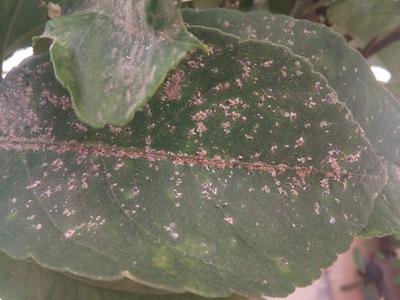Red Scale
Aonidiella aurantii
Insect
In a Nutshell
- Red scales attack all aerial parts of the tree including twigs, leaves, branches and fruit by sucking on the plant tissues.
- Severe infestations cause leaf yellowing and drop, die back of twigs and limbs, and occasionally death of tree.
Can also be found in
Symptoms
Numerous, tiny dark-brown to red scales are found on leaves (often along the main vein), twigs, branches and fruits. They look like raised, conic spots with a somewhat clearer center (volcano-like shape). A yellow halo can be observed around the spot where they feed. At heavy infestations, leaves will wilt, fall prematurely and defoliation will ensue. Infested twigs will die back, something that may extend to larger branches in cases of severe infestations. Fruits may be encrusted by numerous scales and grow deformed, eventually drying out and falling off the tree. Young trees may be severely stunted, or even killed if several of the branches die back. Red scale also excretes honeydew and may lead to the formation of sooty mold on leaves and fruits.
Recommendations

Organic Control
Natural enemies of Aonidiella aurantii include the parasitic wasps Aphytis melinus and Comperiella bifasciata and the predatory mite Hemisarcoptes malus which attack the crawlers. Control of ants is key for biological control of red scale, as those protect scales from natural enemies. Organically approved petroleum oil spray can also be used to rid leaves and fruits from scales. After harvest use high-pressure washing to get rid of scales on your fruits.

Chemical Control
Always consider an integrated approach with preventive measures together with biological control, if available. Sprays with narrow range oil have minimum disruption to natural enemies and are best applied in mid-summer. Corrective chemical spray should be applied when more than 25% of fruits are infested. Use insecticides selectively on parts of the orchard where the number of scales exceeds this threshold. Avoid use of broad-spectrum insecticides that could disturb beneficial insects.
What caused it?
The symptoms are caused by the feeding activity of the red scale, Aonidiella aurantii. It is a major pest of citrus worldwide, common in the tropics. They survive after harvest on wood and leaves, infesting new growth in the next growing season. In their mobile phase, females are highly attracted by light in their search for a feeding spot. They do not lay eggs but gives birth to very active crawlers. Once settled on the upper side of a leave or on depressions on young fruits, they become immobile. After a short phase in which they are covered by a cottony substance, they eventually acquire their circular flattened form and their characteristic reddish-brown color. Their life cycle is closely correlated to temperature and the health of the tree. Thus, greatest damage usually occurs at the end of summer, when trees may suffer from moisture stress.
Preventive Measures
- Use pheromone traps to attract females and assess the severity of the infestation.
- Monitor your orchard regularly for signs of scales and scrape them off if in low numbers.
- Remove heavily-infested twigs or branches.
- Prune trees adequately to improve aeration within the canopy, creating unfavorable conditions for scales.
- Place traps or obstacles to catch or hinder ants that cater for the scales.
- Do not use broad-spectrum insecticides that could affect beneficial insects.
- Minimize dust coating of leaves and fruits by watering roads and washing trees.



